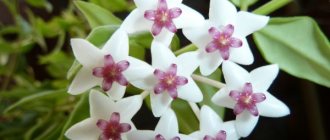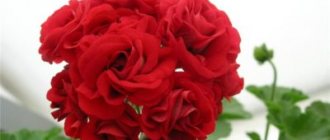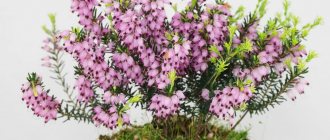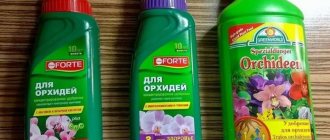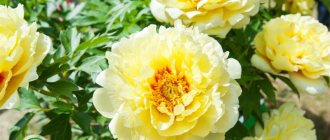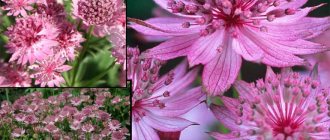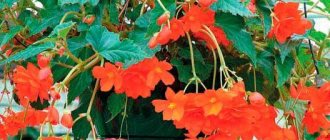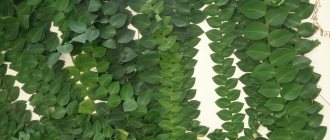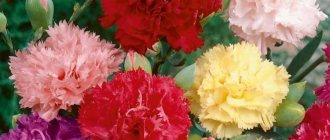Plants » Flowers
1
282
Article rating
Kira Stoletova
An exotic guest from Indonesia and Malaysia, Hoya Lacunosa, has taken root and adapted in European countries. Now it is also successfully grown by flower growers in the former CIS countries. A plant with decorative leaves and amazing fragrant flowers adorns the living collections of millions of people.
Hoya lacunosa photo
Description of the plant
Botanical name: Hoya lacunosa.
This epiphytic hoya in nature lives in close connection with the trees around which it twines and with ants. It is also called concave because of the unusual shape of the leaves - they are small, diamond-shaped, with a curved core. On the back side the leaves have a glossy shine. The shoots do not curl, but cascade. This is a distinctive feature of the Lacunosa species.
The flowers are unusual, white, shaped like fluffy balls with a creamy star in the center. Collected in inflorescences of 20 pieces, drops of nectar do not stand out on the surface. The aroma is pleasant, sweetish, reminiscent of expensive perfume, intensifies at night. Hoya blooms from May to August. Sometimes it can produce flower stalks in early spring - in March.
Give the plant a beautiful shape
Hoya "Carnosa" held with a special device.
The crown is formed by pinching every fourth leaf. Shoots that have grown too long are cut off - this promotes abundant and intense flowering. For support, string is used, which is attached to a window or wall.
You can purchase a special support in the store. It consists of plastic or metal rings mounted on supports. The structure is stuck into the ground, and a plant is carefully placed in the middle of the rings. In this case, the pot should be heavy enough so that the flower does not fall on its side.
Varieties
The Lacunosa species has several artificially bred varieties. Each of them has characteristics of growth, flowering and maintenance. To successfully grow a flower, you need to decide on its variety so as not to make mistakes in creating favorable conditions for it.
Eskimo
The variety is interesting in the shape of its leaves - they are small and heart-shaped. True, they acquire this appearance only in bright light. In partial shade they stretch out and lose their decorative effect. There are two varieties - just Eskimo and Eskimo Silver. The latter is distinguished by a silvery coating on the leaves, the so-called “splash”.
It blooms with white graceful buds with a pleasant hyacinth aroma. The variety received the name “Eskimo” for the color and shape of the flowers - they are creamy-white, fluffy, very reminiscent of the famous ice cream. The aroma intensifies at night. For active flowering, the plant needs a lot of light.
Laos
The leaves are large, dense, with cream-colored specks. In the light they turn brown and the specks turn white. The vines are powerful and do not break under their own weight. They do not require special support. The variety has a long flowering period. The aroma of the buds is reminiscent of incense.
Hoya lacunosa popsicle photo
Heart shape leaf
The shape of the hoya leaves of this variety is heart-shaped, but it becomes so in bright light. In the shade, the leaves begin to stretch and lengthen. The emerald green color gives way to pale turquoise. The flowers are white with a delicate aroma that intensifies at night.
Bold
The leaves have an interesting pattern of depressed and protruding areas. The vines do not curl, but hang down in a cascade. Flowers are spherical, cream and white. The peduncles are elongated, the buds are collected in inflorescences of 15-18 pieces. The aroma of flowers is reminiscent of chocolate.
Tove
The variety is distinguished by pale purple flowers and diamond-shaped leaves up to 6 cm long. In good light, the leaves turn burgundy. Hoya Tove does not tolerate heat; at high temperatures it begins to hurt and is affected by pests.
Langkawi Island
A miniature variety with the smallest leaves of a dark, almost black color. There is a light silvery splash across the surface of the sheet. It blooms with white, fluffy buds, with a cream star in the middle. Has a pleasant incense scent.
Snow Caps
The castings are elongated, light green, with white splashes. The vines reach 5 meters in length, and aerial roots form on them in large numbers. The flowers, as is clear from the name of the variety, resemble snow caps. They are fluffy, white, smell pleasant and strong.
Hoya Lacunosa Royal Flush
Royal Flush
The leaves can change color depending on the lighting. In partial shade they are green, monochromatic, without inclusions. In the light, the leaf acquires a bronzed tint; in good light, silvery specks appear. It blooms rarely and only with excess sun. The variety is resistant to diseases, both bacterial and viral.
Hoya concave (Hoya lacunosa) - description, cultivation, photo
Plants » Flowers
0
1038
articles
Kira Stoletova
The exotic flower Hoya belongs to the Lastovnevy family. It lives in the warm climate of Asia, Australia, America, India, and tropical islands. The plant was named after Thomas Hoy, an English gardener who was the first to study and grow different species in a greenhouse.
Hoya photo indoor photo
Description of species with photos
Hoya lacunusa has the following subspecies.
Miniature plant. In sunlight, the leaves have a dark purple, beetroot hue. Globular inflorescences of cream color with a yellow center. The flower size is 6 mm, there are more than 20 of them in the inflorescence.
Snow Caps
Silver leaves. Their width is 2 cm, and their length is up to 5 cm. The corolla and crown of the flower are snow-white, diameter 10 mm. This variety grows quite slowly compared to its counterparts.
Hoya Lacunosa Eskimo
The plant has diamond-shaped leaves of a dark green color with a glossy sheen.
The flowering process does not take long to occur and blooms profusely. It also smells similar to women's perfume.
Royal Flush
It is distinguished by small leaves of a dark bronze color with silver inclusions on them. Leaf length 6mm. Royal Flush inflorescences are round, white. The new sprout has a reddish-brown tint.
LiveInternetLiveInternet
Hoya lacunosa eskimo pie
s/s cuttings of Hoya rotundiflora (aka hoya sp. rectangle leaf) 2 nodes - 30 UAH, 4 nodes -60 UAH. lakunosa popsicle silver, 3 knots - 40 UAH.
Lacunosa cv. 'Eskimo'. alocasia wrote: this one is also a beauty. March 15, 2015
Hoya wax flower: care, propagation, types of Hoya.
This plant with long strong shoots and thick shiny leaves blooms with small, as if made of wax, flowers that look like stars and smells dizzyingly! For many indoor plants, winter becomes a serious test: there is not enough light, the room is too dry and warm.
Fortunately, there are some plants that like these conditions. They grow and bloom for decades, becoming a family heirloom. For many gardeners, wax ivy is known for precisely these properties. In the 50s and 60s of the last century, it grew in almost every home. Times have changed, and this plant has disappeared from the category of indoor plants.
However, recently there has been some revival among its lovers, and in Sweden, for example, a wax ivy breeding society has been created, which even publishes its own newsletter and sells cuttings. His registry includes 199 species and subspecies of hoya, or wax ivy.
Hardy bindweed Wax ivy belongs to plants of the genus Hoya (Hoya). These are all climbing plants or plants with drooping shoots. Usually 6 - 7 different bindweeds are purchased at once. Various types of hoya are grown either in hanging pots or together with supporting plants around which they can twine. They take up little space and look very decorative.
I bought myself a lacunosa eskimo. May 22, 2015
Hoya develops well all year. However, it does not tolerate excessive humidity in winter. Hoya care is best kept on the east side. In principle, a northern window sill is also suitable, however, during flowering the plant may not have enough light there.
When watering, excess water from the saucer under the pot should be drained, and the root ball should periodically dry out slightly to keep the roots healthy. It is enough to fertilize Hoya two or three times during the entire growth period (it is advisable to fertilize it with a solution of natural manure).
The flower feels good in a small pot. The soil should be changed every three years. It should be greasy and loose - a mixture of sand, peat and leaf compost is best. The plant should always be planted at the same depth. Hoya is easily propagated by cuttings.
In densely leafy varieties, the very tip of the shoot is taken for propagation; in other varieties, the entire shoot can serve as a cutting. For rooting, the shoot is divided into parts (each with two pairs of leaves). The lower leaves need to be plucked off or trimmed, and the cuttings should be stuck into the soil.
The attachment points of the lower leaves should be above the soil. Water thoroughly. The cuttings take root best under a polyethylene dome with air holes.
Lacunosa "Langkawi". Attached files. Hoya Lacunosa Langkawi.JPG (87.1 KB). User. Messages: Registration: 12/01/2013.
Hoya in nature Hoya comes from the tropical wilds of Australia. Wrapping around tree trunks, hoya reaches for the light and, having found a sunny place, blooms flowers. The wild species of the plant is called Hoya australis.
True wax ivy Hoya carnosa is the most common type of hoya (in books it is called wax ivy, other types are simply called “hoya”). The plant propagates easily; for more than 100 years its cuttings have been traveling from house to house. This species blooms with beautiful inflorescences consisting of white “stars” with a red center.
Variegated Hoya Variegated plant form, Hoya carnosa 'Variegata' Tricolor. She is beautiful and hardy, but grows slowly. It has thick dark green leaves with white and pink veins and scarlet flowers. She produces new flower umbrellas all year round. Hanging Hoya Linear Hoya (Hoya linearis) is a special plant for hanging pots.
Its oblong narrow leaves, similar to bean pods, grow on long shoots. The plant has many umbellate white flowers. The most unpretentious hoya, Hoya lacunosa, resembles ordinary wax ivy, but its flowers are half the size. It is grown both in hanging form and together with supporting plants. The light green leaves have a beautiful dark edge.
New umbels of white flowers grow all year round. In the evenings, you can smell their light, pleasant scent in the room. Asterisk to asterisk Flowers of all types of hoya are very similar to each other. On the five-pointed star there is a second, small star. It can be the same color as the first one or different.
And the flowers of the Multifloral Hoya (Hoya multiflora) look like shooting stars (in English the flower is called Shooting stars). Wax ivy flowers “cry” with large sweet tears, which specifically attract insects that pollinate the flower.
Flower care
Hoya lacunusa is a popular plant among gardeners. It is not picky in care, so even beginners can grow it. However, he still has his preferences.
- Loves windows facing north or northwest.
- Able to grow exclusively under artificial light.
- The best option for additional light is a fluorescent lamp.
- In summer it is important to protect from the sun, otherwise drying out of the foliage cannot be avoided.
- The lighting period is 14-16 hours a day.
- During the active growing season, the temperature ranges between +17-22°C.
- In winter it should be maintained at +12-15°C.
- The temperature may drop to +10°C, but not less.
- It grows poorly in low humidity.
- Water procedures will not be superfluous: spraying, warm shower.
- It is recommended to ventilate the room daily.
- In summer, the plant is watered approximately once every 2-3 days, sometimes less often.
- Hoya tolerates drought more easily, because with the slightest lack of moisture, the root system quickly begins to rot.
- In winter, once every 2 weeks.
- Use soft, settled water, without impurities.
- Mineral fertilizers are applied approximately 2 times a month.
- You should choose preparations for flowering plants. The main component is potassium.
- During the cold period, it is better to refuse fertilizing.
- A suitable substrate should be loose, light and fertile.
- The flower is suitable for soil for indoor palm trees or orchids.
- Replant every 2-3 years or as needed.
- Long, lifeless, dry shoots are trimmed.
- Regularly wash dust from leaves with soapy water.
Features of home care
Hoya - types and varieties, home care
The liana is demanding on regular bathing and air humidity.
During the growing season, the temperature ranges from +17 to +22 degrees, in winter - from +12 to +15 degrees.
The plant requires diffused light. In the northern regions in winter it needs additional lighting.
The soil should remain slightly moist during the spring and summer months. In winter, the amount of watering is reduced to 3 times a month.
The liana requires regular showering and spraying.
Spraying the vine
Humidity levels are at 60%.
Purchase and adaptation
Immediately after purchase, the plant needs adaptation.
Hoya does not like to move. Even a simple move from one window to another is stressful for her. After being transported from another country, it is generally incredibly difficult for a flower to get used to the new microclimate and conditions of detention.
Important! For the first 2-3 weeks, the plant should be kept separately from other indoor flowers. Exotic imported varieties can be infected, and local specimens grown from cuttings or seeds are not always healthy. Hoya needs to be closely monitored, noticing the slightest changes in its condition.
After two weeks, it is advisable to transplant the wax plant into a new pot with soil suitable for succulents. The first transplant is carried out regardless of the season. Then the plant is placed in a permanent place and is no longer moved. It is better to hang the vine in a pot on the wall or on a window where it will have enough light.
Soil and fertilizing
Hoya
Don't know what soil to use for planting hoya? Loose, breathable soil with a neutral acidity level is best suited. However, in most cases, the culture is unpretentious to the quality of the substrate. Professional flower growers use special soil for orchids, which can be purchased at flower shops, or make their own mixture by mixing peat, turf soil and sand in equal quantities.
Wax ivy reacts extremely positively to mineral fertilizing during the growing season, but it is best to refrain from organic matter. As fertilizers, you can also purchase special mixtures intended for orchids or succulents. If you follow the instructions for the drug, 1 feeding for 2 weeks will be enough. Remember that excess nutrients can negatively affect the health of the flower.
It is strongly not recommended to fertilize the flower immediately after replanting (provided that new soil is added). It is best to wait two to three months and only then start fertilizing. In winter, the vine is also not fed, since an excess of microelements in the soil can prevent it from entering the hibernation phase. But during the formation of buds, you can and should add mineral fertilizers to the water, because this will affect the size of the flowers!
Landing rules
Hoya is very light-loving, so the place for it should be sunny and warm. South-eastern or southern windows are preferable. You can’t keep hoyas on the northern ones, but on the western ones you will have to add additional lighting. Pots with flowers look great right on the window or on the wall near the window. Once you have chosen a place, you no longer need to turn the flowerpot.
Hoya lacunosa tove
The soil for hoya should be as soft and loose as possible. Purchased soil for cacti is suitable, but it must be diluted with baking powder. Then you should additionally add a little leaf turf. Hoya is an epiphyte, which means it needs leaves and humus for nutrition. The further growth and flowering of the plant depends on the correct soil.
Possible problems in growing
Compared to other types of hoya, lacunosa rarely gets sick.
Pests
Of the parasites that can threaten her:
- spider mite;
- aphid;
- mealybug;
- scale insect
They are treated against them with insecticides and acaricides intended for indoor plants, for example, the drug Fitoverm.
Other problems
Hoya extremely does not like drying out the earthen ball. As soon as the buds appear, you cannot move the pot from place to place. After winter, the vine is “awakened” by immersion for 1 hour in a bath with water heated to 30 °C. Watering with a potassium-rich potato decoction will help strengthen your immune system.
Hoya diseases:
- bacterial. They manifest themselves as the leaves and shoots become soft and sticky. Treatment with preparations containing copper helps;
- viruses. They form thickenings and spots on the leaves. Practically untreatable;
- fungi. Stunted growth and rotting roots are typical signs. It is necessary to change the soil and treat the roots with crushed activated carbon.
Note! Yellowing of the leaves usually indicates a violation of the maintenance conditions: hypothermia and flooding of the roots, overdrying, drafts, sunburn.
The necessary conditions
Hoya Lacunosa is unpretentious; apartment conditions suit her perfectly. However, it is worth considering some features of these succulent vines. By ignoring them, you can even ruin the flower.
Humidity
All succulents are drought-resistant. They do not need high humidity. Even 30-35% is enough for the plant to feel great. Sometimes on hot days the hoya is sprayed with warm water from a spray bottle. Once a year, the plant is even given a “shower” by placing it in a bathtub and watering it from the rain. But this must be done when the plant does not bloom.
Temperature
The average temperature is +22-25°C. In winter, a decrease to 16 ° C is possible, although this is not necessary. Wax ivy does not need dormancy as much as other flowering plants. Although flowering after it will always be more magnificent.
At constant temperatures around +22 °C, hoya can bloom all year round. Few inflorescences will form, but a super pleasant aroma will reign in the house. Lowering temperatures to +15 °C and below is undesirable for a heat-loving vine. At +10 °C it can die.
Lighting
Hoya needs a lot of light; it should always fall the same. The flower does not tolerate rearrangements. The brightness and even color of the leaves depends on the degree of lighting. It can vary from pale green to deep burgundy. In bright light, the plant produces more flower stalks and blooms longer.
How to care for Hoya lacunosa at home: transplant rules
Hoya lacunosa is a popular indoor vine that attracts attention with its large foliage and unusual inflorescences. Simple care allowed her to enter the ranking of plants loved by gardeners.
What it looks like, what family it belongs to
The culture is a representative of evergreen vines of the Kutrov family, the Lastovnevy subfamily.
The foliage of the plant is double-sided: the back is shiny, and the front is matte. The leaf grows up to 6 cm in length and up to 2.5 cm in width. Initially they are reddish-brown in color, then become dark green.
Hoya lacunosa
The stems are greenish in color with a reddish undertone and are represented by numerous vines. 15-20 inflorescences with a white or pinkish color are located on thin branches. The aroma from the buds intensifies in the evening.
The plant has been cultivated at home since 1826. New varieties have variegated rather than classic green foliage.
Attention! The crop is not recommended to be grown in homes with animals and small children, because hoya is poisonous.
Common varieties
The description indicates the following varieties:
- Tove - with a miniature size, the foliage is colored purple. The inflorescences have a cream tone and a yellowish core. The diameter of the buds is up to 6 mm.
- Snow Caps - Silvery foliage grows up to 5cm long and 2cm wide. The flowers are snow-white, up to 10 mm in diameter. Refers to slow growing varieties.
- Hoya Eskimo (hoya escimo) - with diamond-shaped glossy foliage, on which greenish-silver spots are randomly located. Hoya lacunosa eskimo has the snow-white buds that are standard for this subspecies. If a silver tint predominates on the leaves, then the prefix “super” or “silver” is added to the main name.
- Royal flash - characterized by dark bronze foliage with small silver spots. The buds of Royal Flash (flush) are white, while the young growth has a brownish-reddish tint.
Important! A distinctive feature of the variety is its smell - during the day it resembles cloves, and at night it resembles incense.
Hoya lacunosa popsicle silver
Features of home care
Hoya - types and varieties, home care
The liana is demanding on regular bathing and air humidity.
During the growing season, the temperature ranges from +17 to +22 degrees, in winter - from +12 to +15 degrees.
The plant requires diffused light. In the northern regions in winter it needs additional lighting.
The soil should remain slightly moist during the spring and summer months. In winter, the amount of watering is reduced to 3 times a month.
The liana requires regular showering and spraying.
Spraying the vine
Humidity levels are at 60%.
Important! When reduced to 40% or increased to 80%, for a certain period of time the changes will not be reflected in the condition of the flower.
The soil is bought at a flower shop (for vines) or a mixture is made of equal parts of peat, humus, river sand and fertile soil.
Important! Drainage must be placed at the bottom of the pot.
Soil enrichment is carried out with solutions for epiphytes. During the growing season, the amount of nitrogen is reduced - under its influence the plant will become watery and soft.
Pruning of the main shoots is carried out regularly - it stimulates the growth of lateral branches. For the first time, pruning is carried out after the formation of 4 leaves on the main shoot.
Features of growing in open ground
Rose Fire flash - description of the variety
Liana is not able to take root in the Russian climate. In summer, the containers are taken out into the fresh air, reinforced with supports and hidden from the sun and wind.
Important! During this period, watering is carried out daily.
When and how does it bloom
Hydrangea Silver Dollar - description
The flowering of a culture has its own characteristics.
Hoya lacunosa blooming
There are up to 20 buds in the umbrella inflorescence, each of them lives no more than 5 days. The petals are painted in a snow-white, cream or pinkish tone, the core is yellow. The first flowers form in May.
The bud has a white fleecy corolla and a crown of the same color with a lemon-colored center. The flower opens up to 6 mm in diameter.
Important! When opening, a characteristic bend of the petals occurs.
The plant blooms in May, each inflorescence lives for about 5 days.
Changes in care during the flowering period
From May until September, the vine needs diffused lighting and space for shoots (they are attached to supports).
Important! The supporting elements should be removable for easy removal when swimming and washing from accumulated dust.
How does Hoya reproduce?
Reproduction by any method occurs without complications.
Seed propagation is practically not used due to the difficulty of purchasing material.
The shoots are cut into 5 cm cuttings and germinated in substrate or water. The first roots will form in a week. To create the necessary humidity for the culture, the cuttings are covered with a transparent cap.
Propagation by cuttings
Foliage is selected with the longest petioles, then they are placed at a slight angle in the soil. Cover the top with a glass container or plastic wrap.
Important! Propagation by foliage lasts 3-4 times longer than cuttings.
The liana reproduces well by layering - the shoots are covered with rudimentary forms of roots. After immersion in the soil they will begin to develop.
To get young, it is enough to secure the shoot in a container, which is placed next to the mother. After a short period of time, a rooted plant is obtained, which is cut off from the main one.
Possible problems in growing
Compared to its relatives, the culture has good immunity and rarely gets sick.
Pests
The main parasitic insects that attack the vine are:
- spider mite;
- aphids;
- mealybug;
- scale insect.
If pests are detected, the foliage is mechanically cleaned with a soap solution and sprayed with an insecticidal composition. The treatment is done several times until the parasite is completely destroyed.
Mealybug
Other problems
Liana does not tolerate excessive dryness of the earthen clod. After the buds appear, the containers cannot be rearranged. To awaken the plant after hibernation, you will need to take a bath by immersing it in water (30 degrees) for an hour. Strengthening the immune system is carried out with a decoction of potatoes.
Common cultural diseases include:
- bacterial infection - causes softening, stickiness of foliage and shoots, requires treatment with store-bought products containing copper;
- viral - determined by thickenings and spots on the foliage, practically cannot be treated, the plant slowly dies and requires being sent to quarantine;
- fungal - provokes rotting of the root system and stunting of growth, requires replacing the soil and treating the roots with activated carbon powder.
Important! Yellowness of the leaves indicates a violation of the maintenance rules: excessive waterlogging or drying out of the soil, burns on the leaf plates from the sun, staying for a long time in a cool room under drafts.
Types of flower
Nurseries offer the following varieties of crops:
- Hoya lacunosa aff. (similar) - has a slight difference in the size and color of the foliage;
- Hoya lacunosa v. snow caps - with dark green foliage and silver inclusions, growing up to 12 cm in length and 2 cm in width, with snow-white inflorescences;
- Hoya lacunosa v. pallidiflora Hook f. - determined by small leaves, more common in the Thai and Malaysian regions.
Hoya Lacunosa Eskimo is of interest not only to professionals, but also to inexperienced gardeners. The unpretentious liana blooms quickly and rarely gets sick, and does not require complex supervision or special skills. If you follow the cultivation rules, the plant will delight you with its unusual aroma throughout the summer.
What a flower looks like: description and characteristics
Hoya Lacunosa, or Hoya concave, is an evergreen tropical vine that belongs to the subfamily Asclepiadoideae and the Kutrov family (Apocynaceae). Natural habitat - India and China, Singapore, Malaysia, Indonesia, Thailand, the islands of Java, Sumatra, Borneo.
Hoya Lacunosa is considered the most popular vine
The epiphyte settles next to large trees that serve as support for it. Under natural conditions, it enters into symbiosis with ants living among its roots. The dark green leaf has a depression, hence the name concave (Latin lacuna - “hollow”).
The leaves of Hoya concave are very dense to the touch
The front side of the sheet is matte, and the back is shiny. The length of the leaves is up to 6 cm, width up to 2.5 cm. The young growth is colored red-brown, gradually becoming dark green. Numerous lashes form a dense, almost curl-free, falling cascade.
The stems are green or with a reddish tint. It blooms with white or pinkish inflorescences of 15-20 pieces. on thin stem branches. It emits a pleasant aroma that intensifies at night.
The most common varieties:
Tove
The crown is distinguished by its miniature size compared to other varieties. The leaf has a characteristic purple color, which becomes more pronounced in the sun. The inflorescence is cream colored with a yellow core. Each flower is 6 mm in diameter, and there are over 20 of them in the inflorescence.
Hoya lacunosa Tove very small size
Snow Caps
Beautiful silvery leaves are up to 5 cm long and up to 2 cm wide. The flowers are boiling white up to 10 mm in diameter. It is considered a slow growing variety.
Hoya lacunosa Snow Caps - slow growing variety
Hoya Eskimo
The diamond-shaped glossy sheet has chaotic silver-greenish spots, which acquire the greatest contrast in diffused but bright light. Hoya Lacunosa Eskimo has white flowers - standard for this species. If the silvery part predominates on the leaves, then the variety is called with the prefix super (super) or silver (silver).
Hoya lacunosa popsicle with spotted leaves
Royal Flush
The leaves are dark bronze in color with small silver inclusions up to 6 cm long. The inflorescences are white. The young growth of Flash (Flash, or Flash) has a reddish-brown color.
Picture 6 Hoya lacunosa Royal Flush with classic white flowers
Since 1826, the plant has been described in botanical reference books and has been cultivated in greenhouses and in homes. The selection of new varieties was carried out along the way of obtaining vines with bright, variegated leaves.
Note! Hoya is poisonous. It is not recommended to have it in a house where small children and pets live. During flowering, the vine emits a very strong aroma, so you should not place it in the bedroom.
Features of care
Proper humidity and regular bathing - this will have to be monitored primarily when growing Hoya at home.
Spraying
The plant not only loves water, it needs warm baths. Long lashes are washed by immersion in a basin of water.
Priming
Optimal composition of the substrate: humus, peat, river sand, fertile soil in equal proportions. A drainage made of expanded clay or pebbles must be placed at the bottom of the pot.
Trimming
For the harmonious development of the crown, it is necessary to regularly shorten the main shoots, stimulating the formation of lateral branches. The first time this is done after the fourth leaf grows on the main shoot.
Types of flowers
How dracaena blooms - what types, proper care
The umbrella inflorescence usually consists of 15-20 buds. Nectar is not released. Each flower lives for about five days. Shades vary among different varieties from boiling white to cream and pinkish. Usually the core is bright yellow. Flowering begins in May.
Flower shapes
The flower consists of a white fleecy corolla and a white crown with a lemon center. Typically, a fully opened flower has a diameter of 5-6 mm. As the petals open, they bend, giving the flowers a characteristic, very memorable appearance.
Flowering period
Hoya usually blooms in May. Each inflorescence lasts for 5 days, after which it fades. But with good care, the vine takes a very long time to expel the buds, and they do not bloom at the same time, replacing each other.
How does it reproduce
Regardless of the variety chosen by the grower, propagation of the vine occurs easily and without complications.
Germination of seeds
Types of peperomia - wrinkled, glabella, polycarpal and pereskoleifolia
Finding hoya seeds on sale is a great success. It's all about their short shelf life. Usually in nurseries, after harvesting, they are slightly dried and immediately sown. Shoots appear in a week.
Rooting cuttings
The optimal cutting length is 5 cm. You can germinate in water or a moist substrate. The first roots should appear within a week. To maintain optimal humidity, rooted cuttings are covered with transparent caps.
Care
The rules for caring for Hoya are simple. This is a persistent plant, which is commonly called “unkillable”. However, certain care features exist and every gardener should know them.
Hoya lacunosa super popsicle
Watering
Thick, fleshy leaves and stems accumulate moisture; the plant can go without water for a long time. But you shouldn’t test its strength. In summer, hoya should be watered 2-3 times a week so that the entire earthen ball is moistened.
If the substrate is chosen correctly, it will be difficult to overwater the flower. Excess liquid will flow into the drainage holes, the roots will not rot.
Still, do not overdo it with watering. In winter, if the temperature in the room drops, it can generally be reduced to a minimum - once a week.
Feeding
From March to October, the plant is fertilized and fed with mineral complexes. In early spring, it is important for the flower to increase its green mass. This requires a lot of nitrogen. Closer to flowering time they provide more phosphorus and potassium.
Suitable fertilizers:
- Uniflor cactus;
- Florovit;
- Etisso;
- Pocon;
- Agricola for cacti and succulents;
- Good power;
- Stimovit.
Types and varieties of date palms
What dates look like at different stages of ripeness:
- Kimri. Within 17 weeks after pollination, the white berries turn green, quickly gain volume and contain 85% moisture. The taste is bitter and tart, which is explained by the high tannin content.
- Halal. For more than 6 weeks, tropical residents watch the ripening dates grow, then harvest the first harvest of the firm, yellow-red, bitter fruit.
- Rutab (Rhutab) - fruit maturity occurs 5-7 weeks after Halal, the tips darken, the water level drops to 35%, the weight decreases, the skin hardens, the pulp becomes soft and sugary.
- Tamr - the fruits dry out, become coarse and darken, and reach full maturity. The humidity of dates is 20%. Sweet berries are fully ready for harvest 3 weeks after Rutaba.
Dates are also classified according to their moisture content:
- dry or hard – humidity 18% (Turi, Zahedi, Sokari);
- semi-hard or semi-soft – 18-23%;
- soft – moisture > 23% (Mazfati, Kabkab, Khasui, Barkhi, Anbara, Khadrawi, Majhul).
The hard fruits are stored for years, but are used mainly by the Bedouins. The dates are laid out on the ground and dried in the sun or buried in the sand, increasing the shelf life to 2 years.
Hard and soft varieties of dates
The pressed berries serve as the “bread of the desert” - “ajue”. Soft and semi-hard varieties are sold in sets.
Transfer
It is not worth replanting the waxweed often. Young vines are transferred to new flowerpots once a year, older ones - once every 3-4 years. The most crucial moment is the first transplant after purchase. The plant is completely removed from the pot, the peat soil is shaken off, and the roots are washed off with water.
Drainage is poured into a pre-prepared flowerpot of the same size as the purchased one. Suitable materials include shards, pebbles, and pieces of polystyrene foam. Then the soil for cacti is mixed with baking powder (perlite, vermiculite) and poured into a container. The flower is placed inside, the roots are sprinkled, but not crushed. The plant can be watered a little.
Basic rules for caring for tropical ivy
How to make potatoes germinate faster before planting
Hoya pubicalix is an inhabitant of the tropics; it is in this climate that it grows well. And the closer the apartment conditions are to natural ones, the more comfortable the vine feels.
Temperature
Hoya pubicalix does not like heat; if the temperature rises for a long time to +25 degrees or higher, it gets sick. For germinating seed material and cuttings, the ideal indicator is +22 degrees, not lower.
Watering
It is recommended to water Hoya pubicalix regularly, taking into account the season. During the intense summer heat, it is necessary to irrigate the foliage of the plant with a spray bottle, which reduces the temperature and humidifies the dry air.
In the autumn-winter period, the frequency of watering is reduced; the flower is watered after the soil dries out.
Soft water is used, standing for two to three days. To soften it, you can use sphagnum moss, which is placed in a container of water.
Lighting
Hoya pubicalix is light-loving, but the lighting should be diffused. It is better to place a container with a vine, including a hanging one, on the western or eastern side of the home.
In summer, hoya should be provided with shading, since if direct sunlight falls on it during the midday heat, burns and pigmentation may remain on the leaves.
In winter, a tropical flower may suffer from lack of lighting and get sick. If it is not possible to keep it in a well-lit area, then it is advisable to provide an additional light source - special lamps.
Suitable soil
You can purchase a ready-made soil mixture designed for indoor succulent plants and cacti. It is moderately light and acidified. But, experienced gardeners prefer to prepare the soil themselves, adding other components to the finished composition. For 500 g of soil take:
- 250–300 g crushed bark;
- 50–60 g perlite or vermiculite;
- 100 g chopped sphagnum moss;
- 100 g each of charcoal and coconut substrate.
A layer of drainage is placed at the bottom of the pot; pieces of foam plastic can be used for hoi; this material does not allow moisture to retain.
Trimming
Not all varieties of Hoi tolerate this procedure as well as pubicalix. Of course, the vine is pruned only if necessary, in order to obtain cuttings for subsequent propagation or if the shoots have grown too long. Dried and damaged parts of the flower must also be removed. For pruning, use a sharp knife with a sterile blade.
Fertilizer application
For full growth and timely, regular flowering, hoya should be fed with minerals. A sure sign of a lack of nitrogenous substances in the soil is slower growth and yellowing of the foliage.
From March to the end of August, fertilizers are applied once every 2 weeks.
It is important to strictly follow the dosage; if you overfeed, the vine may die
Choosing a pot
Hoya pubicalix does not require spacious containers; even an adult liana needs a pot with a volume of 1-1.2 liters. Plastic, shallow tanks are suitable for her; the roots of the flower grow moderately
But it is important that the pot has holes to drain excess moisture. Replacement of the container is required infrequently. To prevent the rhizome from being torn out of the ground under the weight of long shoots, it is advisable to provide supports for an overgrown vine
To prevent the rhizome from being torn out of the ground under the weight of long shoots, it is advisable to provide supports for an overgrown vine.
Reproduction methods
Hoya is characterized by simple and trouble-free propagation. In many varieties, aerial roots form directly on the vines. This makes it easier to root the cuttings. There are also other ways to propagate wax ivy.
Seeds
At home, seeds rarely ripen, but they can be found on sale. They are first soaked in stimulants, then sown in a light substrate. The container is covered and placed under a regular incandescent lamp to create a greenhouse effect. The temperature should be within +27 °C.
Mouths appear on days 10-14. From this moment on, it is necessary to collect condensate and periodically ventilate the “greenhouse”. Gradually, the seedlings will become accustomed to the microclimate in the house. After a month, the greenhouse can be removed. They will grow to the state of an adult plant for another 2.5-3 years.
Cuttings
The fastest and most reliable method. Cuttings are cut from vines; you can take segments with aerial roots. Each is dipped in Kornevin, then placed in the substrate. There is no need to cover the top. Rooting occurs in 2-3 weeks.
Hoya lacunosa snow caps
To speed up the process, you can raise the temperature and water the plant more often. As soon as young leaves appear, the plant is considered to have taken root favorably. Already next year, young hoya can bloom.
Leaf
If a leaf accidentally breaks off from a vine, you do not need to throw it away immediately. After keeping it in “Kornevin” for a day, it is planted in a very light and loose substrate. If the leaf has at least the rudiments of a petiole, there is a chance to grow a full-fledged seedling. The leaf takes root in 1-2 weeks. The attempt is considered successful if new shoots begin to grow next to the leaf.
When and how does it bloom
Unlike other types of hoya, lacunosa, when blooming, does not close its flowers until they completely wither. In addition, the aroma of the inflorescences is clove-like during the day and incense-like at night.
Types of flowers
Hoya Bella - home care
The umbrella inflorescence usually consists of 15-20 buds. Nectar is not released. Each flower lives for about five days. Shades vary among different varieties from boiling white to cream and pinkish. Usually the core is bright yellow. Flowering begins in May.
Flower shapes
The flower consists of a white fleecy corolla and a white crown with a lemon center. Typically, a fully opened flower has a diameter of 5-6 mm. As the petals open, they bend, giving the flowers a characteristic, very memorable appearance.
Flowering period
Hoya usually blooms in May. Each inflorescence lasts for 5 days, after which it fades. But with good care, the vine takes a very long time to expel the buds, and they do not bloom at the same time, replacing each other.
Changes in care during the flowering period
From May until almost the end of summer, it is necessary to provide the vine with bright but diffuse lighting, as well as space for the lashes, which must be constantly attached to the support.
Note! For support, it is worth using detachable elements so that the vine can be easily removed and washed from dust.
Diseases and pests
| Problem | Cause | Treatment | Prevention |
| Doesn't bloom | Little light and nutrients | Place in full sun and fertilize well | Do not remove the flowerpot from the light |
| Doesn't grow | Low nitrogen, poor lighting | Apply nitrogen fertilizer and expose to light | Follow the feeding regime |
| Leaves curl and dry out | Cold | Place the flowerpot in a warm room, place a heater nearby | Avoid sudden drop in temperature |
| Leaves fall | Dry air | Place the plant under the shower | Spray the leaves |
| Powdery mildew | Low humidity, the room is not ventilated | Tilt, Quadris, Skor, Topaz | Ventilate the room, spray with soapy water |
| Shchitovka | Warm, low humidity, the room is not ventilated | Karbofos, Neoron, Fitoverm | Maintain watering and humidity regime |
| Spider mite | High room temperature, dry air | Aktellik, Antiklesch, Fufanon | Maintain watering and humidity regime |
Kinds
The most famous and decorative plant species are:
- Hoya Pubicalix Silver Pink - has variegated brown-scarlet foliage and lush pale pink inflorescences;
- Splash is a Swedish variety with umbrella inflorescences and pink flowers;
- Hoya Pubalyx Red Button is the most famous variety, with double red buds;
- Black Dragon - a variety with dark gray outer petals and scarlet in the middle;
- Chimera is a bush with lush spherical inflorescences, the petals of which are painted in grayish-lilac shades;
- Royal Hawaii Purple is a shrub with dark green glossy foliage and black and red flowers;
- Beauty is a very beautiful flower with fluffy cream petals.
Wax ivy can outshine many indoor plants with its beauty.
Not all flower growers know about the Hoya Publicis flower, how it forms buds and blooms. But varieties such as Silver Pink and Red Button can outshine many indoor flowers with their beauty and exoticism.
Hoya flower at home
This plant is surrounded by many superstitions and beliefs related to whether it is possible to keep wax ivy at home. According to some superstitions, Hoya is called a muzhegon; grown men supposedly leave the house where he grows up.
According to other beliefs, fleshy hoya, on the contrary, pacifies resentment and envy.
All these are just beliefs. But in fact, waxweed is a beautiful, ornamental plant that purifies the air and pleases the eyes of its owners. In addition, it is used in folk medicine to treat furunculosis and other diseases. So it’s definitely worth keeping Hoya wax ivy at home; it’s easy to care for and beautiful to look at.
